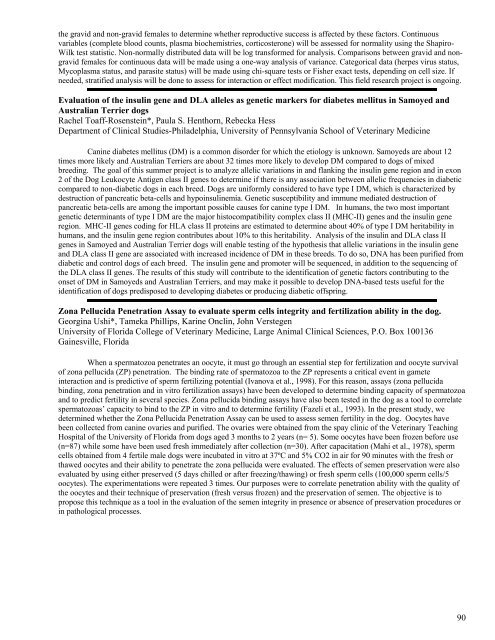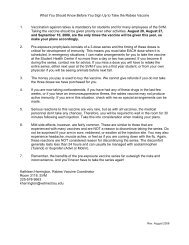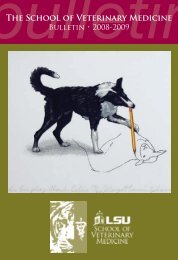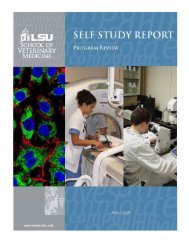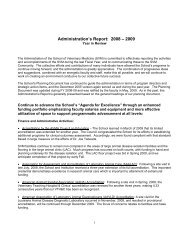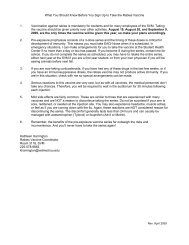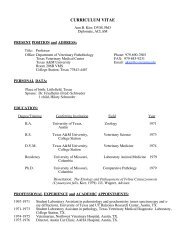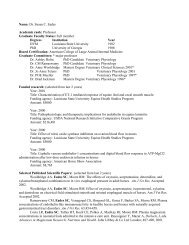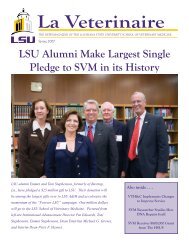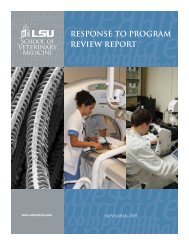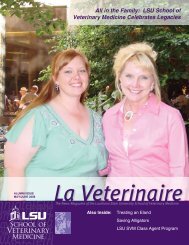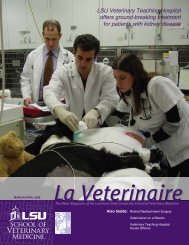the gravid and non-gravid females to determine whether reproductive success is affected by these factors. Continuousvariables (complete blood counts, plasma biochemistries, corticosterone) will be assessed for normality using the Shapiro-Wilk test statistic. Non-normally distributed data will be log transformed for analysis. Comparisons between gravid and nongravidfemales for continuous data will be made using a one-way analysis <strong>of</strong> variance. Categorical data (herpes virus status,Mycoplasma status, and parasite status) will be made using chi-square tests or Fisher exact tests, depending on cell size. Ifneeded, stratified analysis will be done to assess for interaction or effect modification. This field research project is ongoing.Evaluation <strong>of</strong> the insulin gene and DLA alleles as genetic markers for diabetes mellitus in Samoyed andAustralian Terrier dogsRachel Toaff-Rosenstein*, Paula S. Henthorn, Rebecka HessDepartment <strong>of</strong> Clinical Studies-Philadelphia, University <strong>of</strong> Pennsylvania <strong>School</strong> <strong>of</strong> <strong>Veterinary</strong> <strong>Medicine</strong>Canine diabetes mellitus (DM) is a common disorder for which the etiology is unknown. Samoyeds are about 12times more likely and Australian Terriers are about 32 times more likely to develop DM compared to dogs <strong>of</strong> mixedbreeding. The goal <strong>of</strong> this summer project is to analyze allelic variations in and flanking the insulin gene region and in exon2 <strong>of</strong> the Dog Leukocyte Antigen class II genes to determine if there is any association between allelic frequencies in diabeticcompared to non-diabetic dogs in each breed. Dogs are uniformly considered to have type I DM, which is characterized bydestruction <strong>of</strong> pancreatic beta-cells and hypoinsulinemia. Genetic susceptibility and immune mediated destruction <strong>of</strong>pancreatic beta-cells are among the important possible causes for canine type I DM. In humans, the two most importantgenetic determinants <strong>of</strong> type I DM are the major histocompatibility complex class II (MHC-II) genes and the insulin generegion. MHC-II genes coding for HLA class II proteins are estimated to determine about 40% <strong>of</strong> type I DM heritability inhumans, and the insulin gene region contributes about 10% to this heritability. Analysis <strong>of</strong> the insulin and DLA class IIgenes in Samoyed and Australian Terrier dogs will enable testing <strong>of</strong> the hypothesis that allelic variations in the insulin geneand DLA class II gene are associated with increased incidence <strong>of</strong> DM in these breeds. To do so, DNA has been purified fromdiabetic and control dogs <strong>of</strong> each breed. The insulin gene and promoter will be sequenced, in addition to the sequencing <strong>of</strong>the DLA class II genes. The results <strong>of</strong> this study will contribute to the identification <strong>of</strong> genetic factors contributing to theonset <strong>of</strong> DM in Samoyeds and Australian Terriers, and may make it possible to develop DNA-based tests useful for theidentification <strong>of</strong> dogs predisposed to developing diabetes or producing diabetic <strong>of</strong>fspring.Zona Pellucida Penetration Assay to evaluate sperm cells integrity and fertilization ability in the dog.Georgina Ushi*, Tameka Phillips, Karine Onclin, John VerstegenUniversity <strong>of</strong> Florida College <strong>of</strong> <strong>Veterinary</strong> <strong>Medicine</strong>, Large Animal Clinical Sciences, P.O. Box 100136Gainesville, FloridaWhen a spermatozoa penetrates an oocyte, it must go through an essential step for fertilization and oocyte survival<strong>of</strong> zona pellucida (ZP) penetration. The binding rate <strong>of</strong> spermatozoa to the ZP represents a critical event in gameteinteraction and is predictive <strong>of</strong> sperm fertilizing potential (Ivanova et al., 1998). For this reason, assays (zona pellucidabinding, zona penetration and in vitro fertilization assays) have been developed to determine binding capacity <strong>of</strong> spermatozoaand to predict fertility in several species. Zona pellucida binding assays have also been tested in the dog as a tool to correlatespermatozoas’ capacity to bind to the ZP in vitro and to determine fertility (Fazeli et al., 1993). In the present study, wedetermined whether the Zona Pellucida Penetration Assay can be used to assess semen fertility in the dog. Oocytes havebeen collected from canine ovaries and purified. The ovaries were obtained from the spay clinic <strong>of</strong> the <strong>Veterinary</strong> TeachingHospital <strong>of</strong> the University <strong>of</strong> Florida from dogs aged 3 months to 2 years (n= 5). Some oocytes have been frozen before use(n=87) while some have been used fresh immediately after collection (n=30). After capacitation (Mahi et al., 1978), spermcells obtained from 4 fertile male dogs were incubated in vitro at 37ºC and 5% CO2 in air for 90 minutes with the fresh orthawed oocytes and their ability to penetrate the zona pellucida were evaluated. The effects <strong>of</strong> semen preservation were alsoevaluated by using either preserved (5 days chilled or after freezing/thawing) or fresh sperm cells (100,000 sperm cells/5oocytes). The experimentations were repeated 3 times. Our purposes were to correlate penetration ability with the quality <strong>of</strong>the oocytes and their technique <strong>of</strong> preservation (fresh versus frozen) and the preservation <strong>of</strong> semen. The objective is topropose this technique as a tool in the evaluation <strong>of</strong> the semen integrity in presence or absence <strong>of</strong> preservation procedures orin pathological processes.90
Sensorimotor behaviour following cortical ischemia in the ratMelanie van der Loop*, Margaret Dykes, Srikanth Kanagal, Gillian MuirWestern College <strong>of</strong> <strong>Veterinary</strong> <strong>Medicine</strong>, University <strong>of</strong> Saskatchewan. Saskatoon, SK, CanadaIn animal models <strong>of</strong> stroke, behavioural impairments during skilled motor tasks have been well characterized.Impairments during more stereotyped movements such as overground locomotion have not been studied extensively. Thepurpose <strong>of</strong> this project was to include a test <strong>of</strong> overground locomotion in a battery <strong>of</strong> commonly used tests <strong>of</strong> skilledmovement in a rodent model <strong>of</strong> ischemic stroke. Stroke was induced unilaterally by devascularization <strong>of</strong> the motor cortex.Deficits were evaluated for up to 6 weeks following surgery, through tests <strong>of</strong> forelimb asymmetry during spontaneousexploratory behaviour, skilled reaching, horizontal ladder walking, and ground reaction forces (GRFs). Performance resultsenable us to quantify deficits and elucidate the extent <strong>of</strong> spontaneous recovery over the 6 week period. Trends in the datasuggest a marked reduction in preferred (impaired) forelimb use for support during exploratory behaviour following stroke,with no evidence <strong>of</strong> recovery. Overall success in reaching was reduced at 48 hours after surgery but showed gradual recoverythroughout the remainder <strong>of</strong> the experiment. Observations <strong>of</strong> horizontal ladder walking and traversing the GRF runwayrevealed no obvious changes in locomotor skill or gait. However, we expect to find subtle changes in GRFs upon furtheranalysis. Subjects were sacrificed at 7 weeks post-surgery and brain tissue was processed to examine the pathology andextent <strong>of</strong> the lesion. Grossly, lesions were consistent between subjects. Overall, this work contributes to stroke research byintroducing a new behavioural measure that examines the effects <strong>of</strong> stroke on less skilled, more stereotyped movements. GRFanalysis may prove sensitive enough to detect subtle deficits in overground locomotion, so that it can be used in futurestudies <strong>of</strong> treatment efficacy in stroke models.Presence <strong>of</strong> Anticipatory Stress and its Impact on Performance <strong>of</strong> Competition DogsPhilip W. Whitley, BS, VT, Lawrence J. Myers, DVM, Ph.D.; Robert L. Gillette, DVM, MSE, Auburn UniversityCollege <strong>of</strong> <strong>Veterinary</strong> <strong>Medicine</strong>; T. Craig Angle, MEd, MEd, ATC, CSCS. Auburn University College <strong>of</strong><strong>Veterinary</strong> <strong>Medicine</strong>We will first contact local agility dog clubs, private dog owners, and Lee County Humane Society to acquire theirparticipation in our research endeavor. Each private dog owner participating in our research will be required to read and signan informed consent agreement (document attached).We will group the participating dogs into cells depending on their ranking <strong>of</strong> novice, intermediate, or advanced. Once thecells are organized we will travel to the dog owner’s home or local kennel and acquire the dogs temperature, pulse,respiration, heart rate, oxygen consumption using a portable pulse oximeter, blood pressure using a tail pressure cuff, andpupillary light constriction using calipers for our control protocol and also assess the dogs behavior. Acquisition <strong>of</strong> bloodpressure and pupillary light constriction will tell us sympathetic nervous system activation to be included in our stressanalysis. All data will be acquired in triplicate to determine statistical variants. Once we obtain baseline measures we willthen ask the owners to bring their dogs to the agility course (see Figure 1 below) at a designated time and place. The agilitycourse will be outdoors, at Auburn University College <strong>of</strong> <strong>Veterinary</strong> <strong>Medicine</strong>, and trials will start in the morning (8:00am to10:00am) so ambient temperatures may be relatively controlled. The dogs will compete on three separate days to betterjustify their individual performance and how fatigue impacts their performance. All activities just prior to, during, and aftercompetition will be videotaped to evaluate behavior. Again, we will acquire the dogs vital signs (temperature, pulse,respiration, oxygen consumption, blood pressure, and pupillary light constriction) and note any behavioral changes prior tocompetition and at this time we will adorn the dogs with an Timex digital ironman external heart rate monitor and Hobo U12data logger internal thermometer (placed rectally with a rear flank harness) so we can acquire data for these parametersduring competition. Each dog will then run the assigned course. Time at midpoint and time for last half will be obtained tocompare. The dog’s entire course time will be used to evaluate performance and comparing first half course time to latter halfcourse time will be used to evaluate fatigue as it relates to performance.Functional Study <strong>of</strong> the Insulin Receptor Kinase IRK-1 from Strongyloides stercoralis UsingCaenorhabditis elegans as a Genetic SurrogateConnie Y. Yeh*, Holman C. Massey Jr., Michelle L. Castelletto, James B. LokDepartment <strong>of</strong> Pathobiology, <strong>School</strong> <strong>of</strong> <strong>Veterinary</strong> <strong>Medicine</strong>, University <strong>of</strong> PennsylvaniaParasitic nematodes, such as Strongyloides stercoralis, have significant economic and public health consequences inboth veterinary and human medicine. Study <strong>of</strong> the mechanisms that govern the infective process in these parasites mayuncover new strategies for the control and prevention <strong>of</strong> parasitic infection. The dauer larval stage <strong>of</strong> the nematodeCaenorhabditis elegans is a specialized, diapausing form <strong>of</strong> the third-stage larva (L3) that is similar to the arrested infectiveL3 <strong>of</strong> parasitic nematodes. The insulin receptor kinase encoded by daf-2 is a key factor regulating dauer development in C.elegans. Our lab has cloned and sequenced the ortholog <strong>of</strong> this gene, designated irk-1, in S. stercoralis. There isapproximately 35% sequence identity between irk-1 and daf-2. We hypothesize that irk-1 has the same developmental91
- Page 1 and 2:
2006 MERCK/MERIALNATIONAL VETERINAR
- Page 6 and 7:
3:00-3:30 pm BreakNovel therapy for
- Page 8 and 9:
KEYNOTE SPEAKERRonald Veazey, D.V.M
- Page 10 and 11:
Mini Symposium II:Fish Research: A
- Page 12 and 13:
David G. Baker, D.V.M., M.S., Ph.D.
- Page 14 and 15:
Konstantin G. Kousoulas, Ph.D.Profe
- Page 16 and 17:
Joseph Francis, B.V.Sc., M.V.Sc., P
- Page 18 and 19:
dogs with cancer, the potential rol
- Page 20 and 21:
2006 MERCK/MERIALVETERINARY SCHOLAR
- Page 22 and 23:
YOUNG INVESTIGATOR AWARD HONORABLE
- Page 24 and 25:
Mammary epithelial-specific deletio
- Page 26 and 27:
2006 MERCK/MERIALVETERINARY SCHOLAR
- Page 28:
Variation in Q-Tract Length of the
- Page 34:
Novel therapy for humoral hypercalc
- Page 38:
ALTERNATE:Micron-scale membrane sub
- Page 42 and 43: ABSTRACT TITLES LISTED BY CATEGORY
- Page 44 and 45: 19. A pilot study of cigarette smok
- Page 46 and 47: 36. Development of a murine in vitr
- Page 48 and 49: ABSTRACT TITLES LISTED BY CATEGORY
- Page 50 and 51: 71. Identification and characteriza
- Page 52 and 53: 85. Age and Gender Influence Ventil
- Page 54 and 55: ABSTRACT TITLES LISTED BY CATEGORY
- Page 56 and 57: 2006 MERCK/MERIALVETERINARY SCHOLAR
- Page 58 and 59: 10. Preliminary estimation of risk
- Page 60 and 61: ABSTRACT TITLES LISTED BY CATEGORY
- Page 62 and 63: 47. Osteoprotegerin and Receptor Ac
- Page 64 and 65: 61. A Comparison of Interaction Pat
- Page 66 and 67: ABSTRACT TITLES LISTED BY CATEGORY
- Page 68 and 69: ABSTRACT TITLES LISTED BY CATEGORY
- Page 70 and 71: ABSTRACT TITLES LISTED BY CATEGORY
- Page 72 and 73: 2006 MERCK/MERIALVETERINARY SCHOLAR
- Page 74 and 75: used to label avian heterophils for
- Page 76 and 77: obtained via analysis of time and d
- Page 78 and 79: 0.71mg/dL; p=0.001). Values for hem
- Page 80 and 81: mass and fecundity in prespawning w
- Page 82 and 83: Equine Hoof Laminae Tissue Collecti
- Page 84 and 85: Aspiration Pneumonia in DogsDavid A
- Page 86 and 87: Distortion Product Otoacoustic Emis
- Page 88 and 89: tyrosine phosphorylation is measure
- Page 92 and 93: egulatory function as its ortholog,
- Page 94 and 95: PATHOLOGY, TOXICOLOGY, AND ONCOLOGY
- Page 96 and 97: Markers of Oxidative Stress in plas
- Page 98 and 99: has been isolated from all samples
- Page 100 and 101: Matrix metalloproteinase secretion
- Page 102 and 103: Reproductive performance, neonatal
- Page 104 and 105: control to determine the efficiency
- Page 106 and 107: Enhancing the Quality and Reliabili
- Page 108 and 109: grade II MCTs into groups with good
- Page 110 and 111: Transcriptional Regulation of the I
- Page 112 and 113: MICROBIOLOGY AND IMMUNOLOGY (SESSIO
- Page 114 and 115: colonization of the mutant and 6 re
- Page 116 and 117: digestive tracts of these and other
- Page 118 and 119: 100 pfu BRSV. The results show that
- Page 120 and 121: Inhibition of Microneme Secretion i
- Page 122 and 123: Adherent bacilli were present in th
- Page 124 and 125: isolated to analyze cytokine gene e
- Page 126 and 127: purified, viral RNA was extracted a
- Page 128 and 129: The effects of co-engagement of TLR
- Page 130 and 131: Occurrence of Leptospira Vaccine Fa
- Page 132 and 133: undifferentiated catecholaminergic
- Page 134 and 135: the concept that the greater detoxi
- Page 136 and 137: quantitative PCR using gene targets
- Page 138 and 139: Rotenone Induced Dopamine Neuron De
- Page 140 and 141:
decrease in serum cortisol, with a
- Page 142 and 143:
and detrimental impacts on the brai
- Page 144 and 145:
actions of cells prior to embryo de
- Page 146 and 147:
Utilizing cDNA Subtraction to Exami
- Page 148 and 149:
expression in unilaterally pregnant
- Page 150 and 151:
Salmonella is increased. Poultry sa
- Page 152 and 153:
exports. The estimated prevalence o
- Page 154 and 155:
eeding grounds near Minnedosa, MB s
- Page 156 and 157:
(PBMC) were isolated using commerci
- Page 158 and 159:
2006 MERCK/MERIALVETERINARY SCHOLAR
- Page 160 and 161:
Trainees acquire in-depth knowledge
- Page 162 and 163:
comparative pathology and/or resear
- Page 164 and 165:
Department of Veterinary Bioscience
- Page 166 and 167:
PhD, Director, Center for Comparati
- Page 168 and 169:
2006 MERCK/MERIALVETERINARY SCHOLAR
- Page 170 and 171:
MICHIGAN STATEUNIVERSITYJames Crawf
- Page 172:
UNIVERSITY OFPENNSYLVANIALindsay Th


